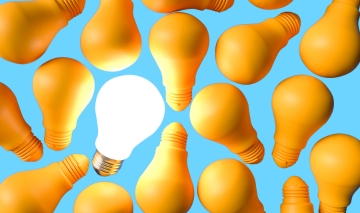Doe de scan en zie waar jij staat.
Hype or reality? Artificial Intelligence and the future of marketing automation

Artificial Intelligence (AI) binnen marketing automation is al langere tijd een gebied waarin veel ontwikkelingen plaatsvinden. De verwachtingen zijn hoog gespannen: Wat gaat het een marketeer of organisatie opleveren?
Een andere ontwikkeling is het ontstaan van (nieuwe) kanalen die nu ook beschikbaar zijn voor B2B-marketing. Denk hierbij bijvoorbeeld aan chat of SMS, maar ook aan communicatievormen die we ons nu nog niet kunnen voorstellen. Welke invloed gaan deze nieuwe communicatievormen hebben op marketing automation?
Artificial Intelligence in marketing automation
De inzet van artificial intelligence in marketingtechnologie is al een tijd gaande. AI helpt je met de juiste inzichten in data, betere strategische keuzes te maken en efficiënter te werken. Marketing automation maakt al gebruik van AI in de vorm van machine learning.
Machine learning zet je in bij het optimaliseren van vooraf bepaalde doelstellingen. Machine learning gebruikt een algoritme om datapatronen te herkennen en hiervan te leren. Zo kun je met machine learning onder andere:
- Je database automatisch segmenteren op basis van profiel en gedrag. Je kunt gepersonaliseerde content tonen in e-mails en op landings- en webpagina’s en productaanbevelingen doen afhankelijk van het profiel van de bezoeker.
- Onderwerpregels van e-mails optimaliseren. Machine learning is in staat om duizenden eerder gebruikte onderwerpregels te analyseren en vervolgens te identificeren waarom bepaalde onderwerpregels een hoge open rate hebben. Met deze inzichten kan het aanbevelingen doen, waarbij de kans het grootst is dat ze een hoge open rate behalen.
- E-mails versturen op het juiste moment waarbij de kans het grootst is dat de ontvanger de mail opent.
- Met predictive analytics voorspellen bij welke prospects de kans het grootst is dat ze converteren of bij welke klanten de kans het grootst is dat ze weglopen.
- Nurture campagnes automatisch optimaliseren, waardoor je het aankoopproces versnelt.
Veel van deze handelingen gaan vaak nog intuïtief en handmatig. AI zorgt ervoor dat we dit kunnen automatiseren en direct optimaliseren.
Succesvolle campagnes
Chatbots
Live chat wordt al volop ingezet. Een goede live chat zorgt ervoor dat een bedrijf makkelijker benaderbaar is voor informatie, support of zelfs voor het doen van aankopen.
Maar, 300 live chats per dag vraagt wat van je organisatie: Kan je sales of klantenserviceteam dit verwerken? Nieuwe generatie conversational AI-platforms, vaak aangeduid als chatbots, bieden hiervoor een oplossing.
Deze chatbots worden ingezet om websitebezoekers te helpen met hun vragen. Denk aan het automatisch beantwoorden van veelvoorkomende vragen. Heeft de klant een additionele vraag of de behoefte om met een medewerker te spreken? Dan is de chatbot in staat om door te schakelen naar een live chat met de juiste persoon binnen de organisatie.
Martech stack
Zo’n chatfunctionaliteit is geen standaard onderdeel van de meeste marketing automation platformen. Naast chat zijn er nog veel meer marketingtechnologieën te bedenken die je zou willen integreren met je marketing automation tool. Denk hierbij aan advertising platforms, social media publishing software, reporting tools, etc. Allemaal onderdeel van je MarTech stack.
Ecosysteem van MarTech tools
Als we kijken naar de behoeften van de marketingafdeling, dan verschillen die per organisatie. Zo kan iedere marktbenadering andere tooling voorschrijven.
Sommige bedrijven richten zich op de grootzakelijke markt, waar een account-based marketing strategie vaak goed voor werkt. Hierbij richt je de marketingactiviteiten op een klein aantal bedrijven in je markt met als doel de engagement te vergroten.
Andere organisaties richten zich op het MKB, waar een demand generation strategie meestal beter werkt. Hierbij probeer je zoveel mogelijk gekwalificeerde leads te krijgen en te converteren naar een gekwalificeerde opportunity.
Weer andere organisaties richten zich op de onderkant van de markt, waar een e-commerce-gerichte aanpak goed kan werken.
Elke strategie vereist andere functionaliteiten. Het is voor een marketing automation platform onmogelijk om aan al de wensen van de verschillende organisaties te voldoen.
Idealiter is er een ecosysteem van verschillende marketingtools. Een ecosysteem dat voldoet aan alle wensen van jouw organisatie. Waarin de verschillende systemen met elkaar integreren en gegevens kunnen uitwisselen. Met de komst van tools zoals Zapier en Microsoft Flow en HubSpot Operations Hub is het integreren en data uitwisselen kinderspel geworden.
Daarnaast breiden de bekende marketing automation oplossingen het aantal systemen waarmee ze standaard kunnen koppelen continu uit. De standaard integratiemogelijkheden zijn daarom ook een belangrijk criterium bij de selectie van een marketing automation platform.
Een lijstje met Marketing Automation platforms en integraties:
- Salesforce AppExchange
- Adobe Exchange
- Oracle Cloud Marketplace
- Act-On Apps & Integrations
- HubSpot App Marktplaats
- Shopify App Store
Marketing automation software vergelijken? Bekijk eerst dit artikel!
Slotwoord
AI gaat de marketeer niet vervangen maar gaat je juist helpen het volledige potentieel uit marketing te halen. Hierdoor kunnen we onze meerwaarde als marketeer nog beter laten zien binnen de organisatie. We blijven in gesprek met onze doelgroep en we kunnen onze creativiteit inzetten met het bedenken van unieke content en campagnes.
Als we onze skills combineren met de mogelijkheden die marketing automation en AI ons bieden, dan is onze nieuwe missie geslaagd. Door het ecosysteem voor ons te laten werken, kunnen we de klant blijven verrassen, de business laten groeien, en ons merk uitbouwen.
Succesvolle campagnes
Doe de scan en zie waar jij staat.
Share this article
Related insights
Grow your B2B Marketing knowledge
Subscribe to keep up with our latest B2B Marketing updates and exclusive events. Straight to your inbox, once a month.



